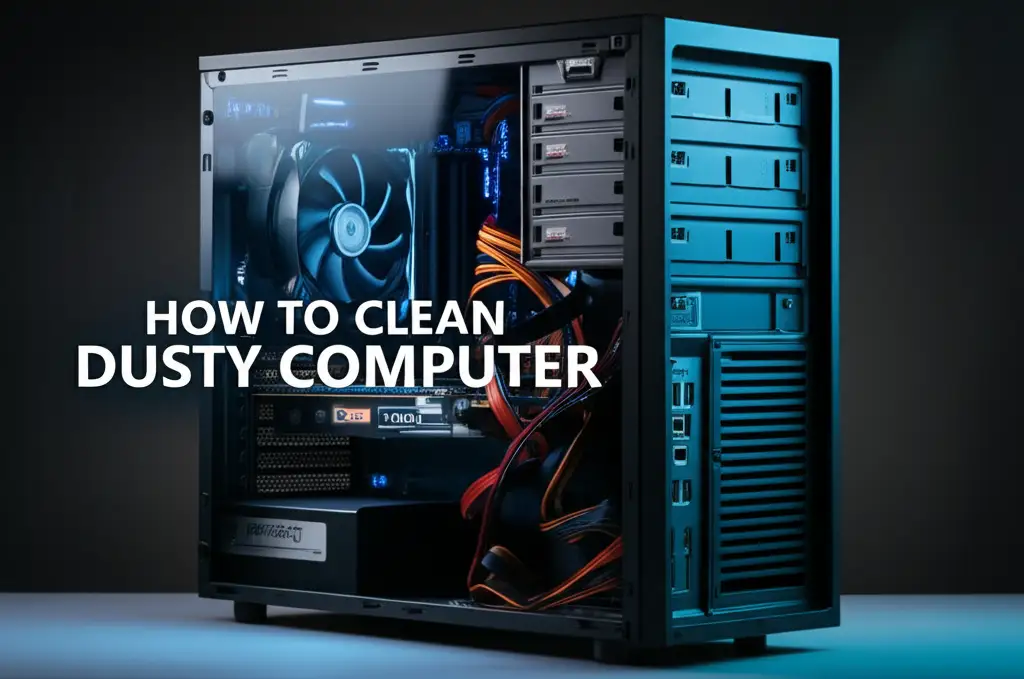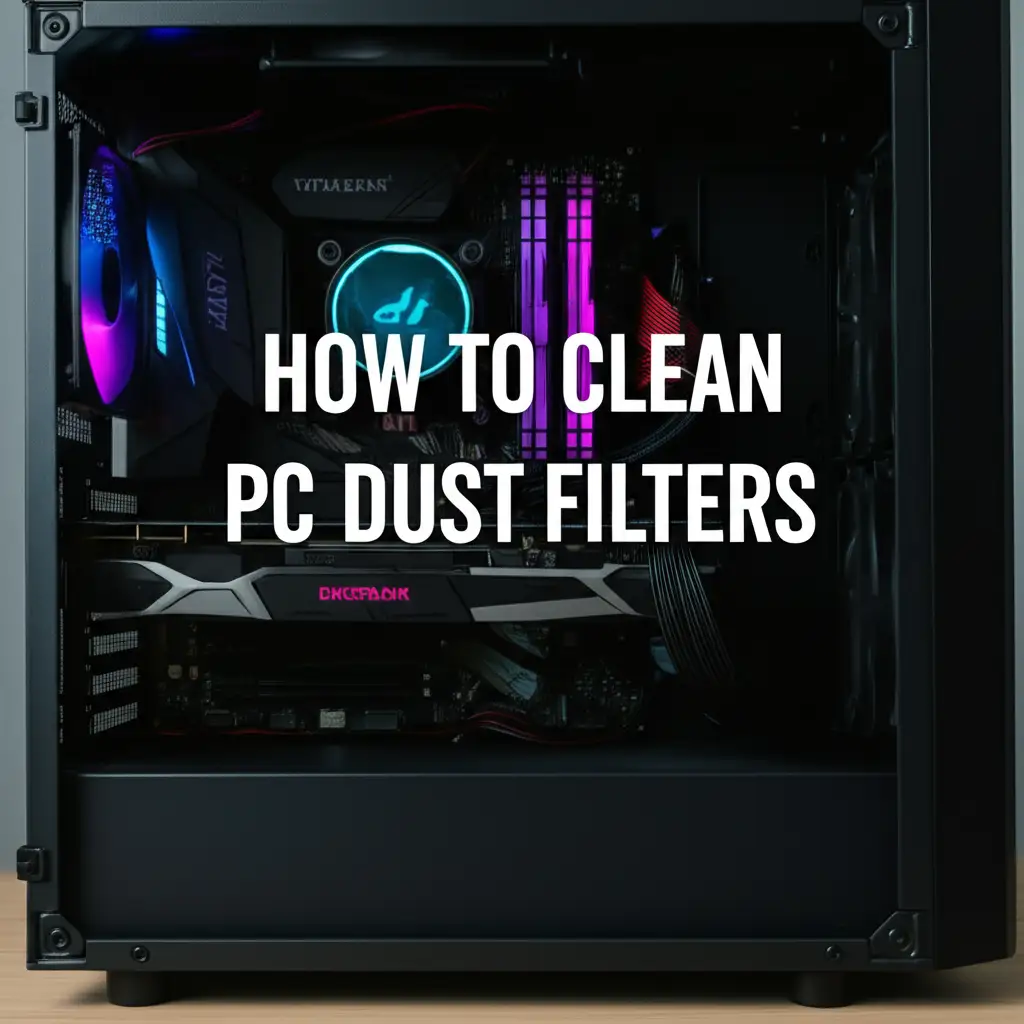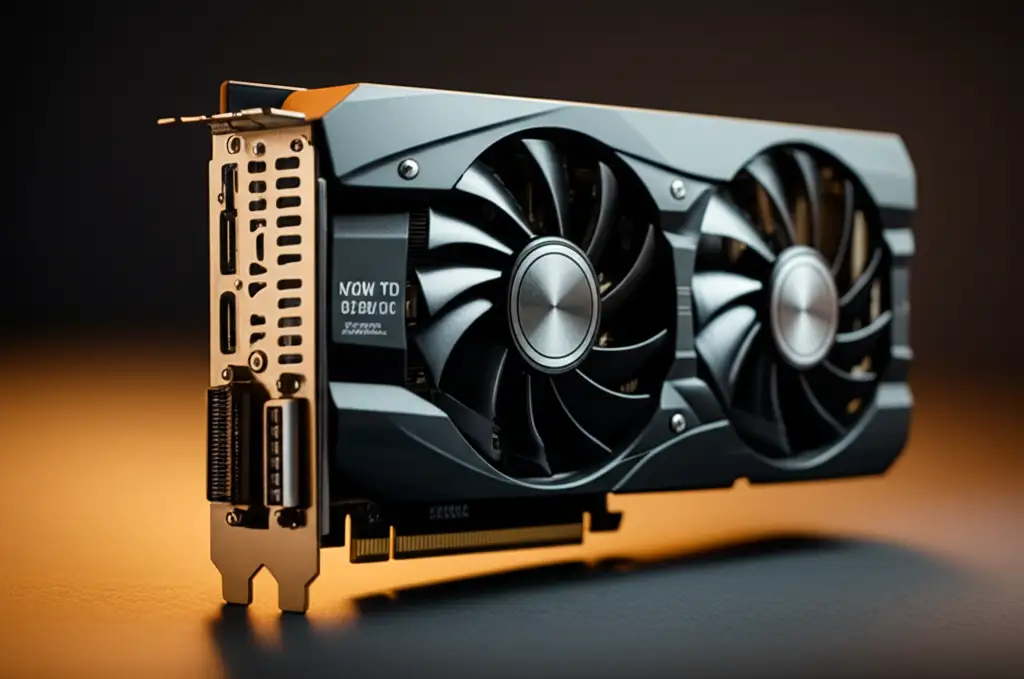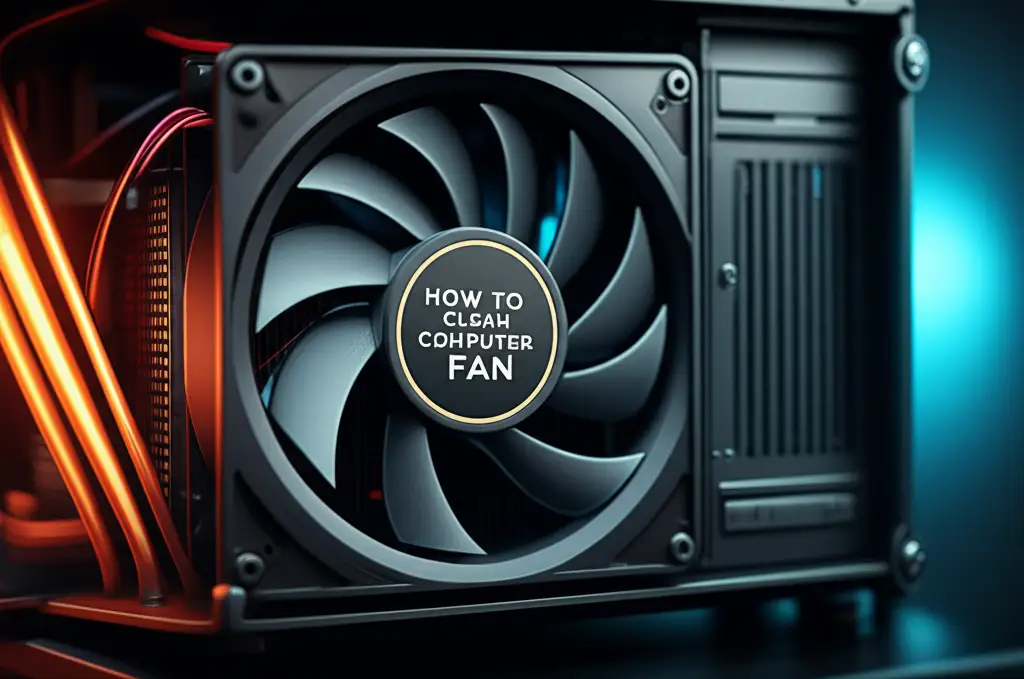· Computer Maintenance · 14 min read
How To Clean Dusty Computer

How To Clean Dusty Computer: Boost Performance & Lifespan
Do you hear your computer fan whirring louder than usual? Does your desktop look like it survived a sandstorm? It sounds like your computer needs a good cleaning. Dust collects inside computers and causes many problems. Over time, this dust can slow your machine down. It can even shorten your computer’s life.
Cleaning your computer is a simple task you can do at home. You do not need special skills. This guide helps you clean your dusty computer safely. We will cover exterior cleaning and detailed internal cleaning. You will learn the right tools to use. We also share tips to keep your computer dust-free. By the end, your computer will run smoother. It will last longer too.
Takeaway
- Regularly clean your computer to prevent overheating.
- Gather the right tools like compressed air and microfiber cloths.
- Clean external parts like the keyboard and monitor often.
- Safely open your computer case to remove internal dust.
- Address specific areas like fans and heat sinks inside.
- Implement habits to reduce dust build-up.
- Avoid common mistakes such as using household vacuum cleaners.
To clean a dusty computer, first turn it off and unplug it. Use compressed air to blow dust out of vents and internal components. Wipe exterior surfaces with a microfiber cloth. For internal parts, carefully open the case and remove dust from fans, heat sinks, and circuit boards. This improves airflow and performance.
Why Dust Harms Your Computer: Impact on Performance
Dust is more than just an ugly mess. It can severely impact your computer’s operation. Small particles get everywhere inside the case. This includes fans, heat sinks, and circuit boards. Dust acts like a blanket, trapping heat. Your computer needs to stay cool to run well.
When dust covers components, heat cannot escape easily. This causes your computer to overheat. An overheating computer slows down. It might freeze or crash unexpectedly. Overheating also shortens the life of internal parts. Think of it like a car engine running too hot. It will eventually break down.
Dust also affects airflow. Fans pull air through the computer to cool parts. If dust clogs the fan blades or vents, air cannot flow. This means less cool air enters. Hot air gets stuck inside. Cleaning helps restore proper airflow. Your computer can then cool itself efficiently. This keeps it running fast and stable.
Furthermore, dust can carry static electricity. Static electricity can damage sensitive electronic parts. While less common, it is a risk. A clean computer is a safer computer. Regular cleaning prevents these problems. It keeps your computer working at its best. Your computer will respond faster to commands. It will also handle demanding tasks better.
Gathering Your Computer Cleaning Tools: Essential Supplies
Before you start cleaning your dusty computer, you need the right tools. Using the correct supplies makes the job easy and safe. Improper tools can cause damage. We want to clean, not harm, your valuable machine. Gather these items before you begin.
First, you will need compressed air. This comes in a can with a small straw. Compressed air is perfect for blowing dust out of tight spaces. It removes dust from fans and heat sinks. Always hold the can upright to prevent liquid propellant from spraying out. You can find compressed air at any electronics store.
Next, get a microfiber cloth. These cloths are soft and lint-free. They are ideal for wiping surfaces without scratching. Use them for monitors, keyboards, and the computer case. Avoid paper towels or rough cloths. These can leave scratches or lint. You can also use cotton swabs for small, hard-to-reach areas.
Consider anti-static wipes or a mild cleaning solution. Use these for external surfaces. Make sure any solution is specifically for electronics. Do not use harsh household cleaners. They can damage plastic or coatings. A small brush, like a clean paintbrush or a dedicated electronics brush, helps loosen stubborn dust.
Finally, a small Phillips head screwdriver might be useful. You might need it to open your computer case. Most computer cases use standard screws. An anti-static wrist strap is also a smart addition. This strap protects your computer from static electricity from your body. You wear it on your wrist and clip it to a metal part of the computer case. This simple step prevents serious damage. Having these tools ready ensures a smooth cleaning process.
Cleaning Your Computer’s Exterior: A Quick Refresh
The outside of your computer gathers dust and grime quickly. Cleaning the exterior improves its look and hygiene. This part of the cleaning process is simple. It does not require opening your computer case. We focus on visible surfaces and accessories.
Start with your computer monitor. Dust settles on the screen constantly. Use a clean, dry microfiber cloth to wipe the screen gently. For tougher smudges, dampen a corner of the cloth with a bit of distilled water. Never spray liquid directly onto the screen. This can cause streaks or damage. Many people wonder how to clean a computer monitor properly. A gentle wipe is usually enough. For very stubborn marks, specialized screen cleaning solutions are available. Ensure they are safe for your screen type.
Next, move to your keyboard. Keyboards collect an amazing amount of dust, crumbs, and debris. Turn your keyboard upside down and gently tap it. This helps dislodge loose particles. Then, use compressed air to blow out dust from between the keys. Hold the can upright and use short bursts. After that, wipe the keycaps and the keyboard surface with a slightly damp microfiber cloth. You can use cotton swabs for tight spots around keys.
Do not forget your mouse. Mice pick up dirt from your desk and hands. Wipe the entire mouse with a microfiber cloth. If it is an optical mouse, clean the sensor on the bottom. Dust on the sensor can make your mouse perform poorly. For wired mice, clean the cable too.
Finally, wipe down the computer case itself. Use a dry or slightly damp microfiber cloth. Pay attention to air vents and grilles. Dust here blocks airflow into the system. These simple steps keep your workstation looking clean. It also helps reduce the amount of dust that eventually enters the internal components. Regular external cleaning prevents dirt from becoming a bigger problem.
Deep Cleaning Your Desktop Computer’s Insides: Tackling Internal Dust
Cleaning inside your desktop computer is crucial for its health. This is where most performance issues from dust occur. It might seem daunting, but it is a straightforward process. Take your time and follow these steps carefully. Safety is the most important part here.
First, power down your computer completely. Unplug all cables from the back. This includes the power cord, monitor cables, and USB devices. Move your computer to a well-ventilated area. A garage or patio is ideal. You want to avoid blowing dust indoors. Lay the computer on its side.
Now, open the computer case. Most cases have thumb screws or regular screws on the back panel. Remove these and slide off the side panel. If you have an anti-static wrist strap, put it on. Clip the other end to an unpainted metal part of the computer case. This grounds you and protects components from static discharge.
Once open, you will see various components. Your main targets are the fans and heat sinks. These are dust magnets. Start by using compressed air. Hold the can upright. Use short bursts to dislodge dust. Begin with larger areas like the case fans. Direct the air away from the inside of the computer. For the CPU cooler, which often has a large fan and metal fins, blow dust out from between the fins. You might need to hold the fan blades still with your finger. This stops them from spinning too fast. Fast spinning can damage the fan bearings. Many people ask how to clean a computer fan; compressed air is your best tool for this.
Next, gently blow dust from the graphics card, RAM sticks, and the power supply unit. For the power supply, be careful. It contains capacitors that can hold a charge. Blow air into its vents from the outside. Do not open the power supply unit itself. Use a soft brush or cotton swab for stubborn dust. Carefully brush dust from circuit boards and cable bundles. Do not touch components directly with your hands. After removing visible dust, reattach the side panel. Plug everything back in. Your computer should now run cooler and quieter.
Cleaning a Dusty Laptop: Specific Steps for Portables
Laptops also collect dust, but cleaning them is a bit different. They are more compact. This means less room for air to flow. Dust build-up can quickly lead to overheating in a laptop. We need to be extra gentle with these portable machines.
Start by turning off your laptop completely. Unplug the power adapter. Remove the battery if it is easily detachable. This ensures no power runs through the system. Move to a clean, well-lit area. You can use a desk or table.
Locate the air vents on your laptop. These are usually on the sides or bottom. Some laptops have vents near the hinge. These vents are where dust collects and blocks airflow. Use compressed air in short bursts. Blow into the vents. Aim to push dust out, not further in. Hold the can upright. You might see dust clouds coming out. This is a good sign. Be gentle. Do not use strong blasts of air directly onto delicate parts.
For the keyboard, use the same method as with a desktop keyboard. Blow compressed air between the keys. This dislodges crumbs and dust. Wipe the keycaps and touchpad with a clean microfiber cloth. If your screen is dusty or smudged, clean it with a microfiber cloth. Dampen the cloth with water if needed. Be gentle with the screen.
Some advanced laptop users might open the bottom panel. This allows access to the cooling fan. If you are comfortable, you can remove the screws on the bottom. Carefully lift the panel. You will then see the fan and heat sink. Use compressed air to clean these components directly. Again, hold the fan blades steady while blowing air. Be aware that opening your laptop might void its warranty. Check your laptop’s manual before proceeding. If you are not sure, stick to external vent cleaning. Regular light cleaning prevents major dust problems.
Preventing Dust Build-up: Keep Your Computer Cleaner Longer
Keeping your computer clean is an ongoing task. Dust is everywhere. But you can take steps to slow down dust build-up. These habits reduce how often you need to perform deep cleans. They also help your computer stay healthy.
First, consider where your computer sits. Place your computer on a hard, flat surface. Avoid placing it directly on carpet. Carpet fibers are a major source of dust. They also block airflow to bottom vents. If you must use it on carpet, place a hard mat underneath. This lifts the computer.
Regularly clean the area around your computer. Dust on your desk or floor ends up in your computer. Wipe down your desk, sweep, or vacuum the floor often. This reduces airborne dust particles. A cleaner room means a cleaner computer. You can also use an air purifier in your computer area. An air purifier helps remove dust particles from the air before they settle.
Check your computer’s filters. Some computer cases have dust filters over their intake fans. These filters catch dust before it enters the case. These need regular cleaning. Remove them and wash them with water or vacuum them. Let them dry completely before putting them back. Clean your filters every few months. This prevents dust from entering the internal parts.
Finally, create a cleaning schedule. Mark your calendar to clean your computer regularly. For most users, a light exterior clean once a month is good. A deep internal clean every 6 to 12 months is often enough. If you live in a dusty area, you might need to clean more often. Following a schedule ensures dust never becomes a major issue. Your computer will thank you with smooth performance.
Common Cleaning Mistakes: Protect Your PC from Damage
While cleaning your dusty computer seems simple, some common mistakes can cause damage. Avoiding these pitfalls protects your valuable hardware. Always prioritize safety and proper technique. Knowing what not to do is just as important as knowing what to do.
One major mistake is using a household vacuum cleaner. Vacuum cleaners generate a lot of static electricity. This static discharge can fry sensitive components inside your computer. Their suction is also too strong. It can dislodge small parts or pull off wires. Stick to compressed air for internal dusting.
Another error is spraying liquid directly onto components. Never spray water or cleaning solutions inside the computer. Even outside, spray liquids onto a cloth first. Then, wipe the surface with the damp cloth. Liquid can cause electrical shorts and corrosion. This can permanently damage your computer parts.
Do not use harsh cleaning chemicals. Ammonia-based cleaners, window cleaners, or general household cleaners are too strong. They can damage plastic finishes, screen coatings, or even circuit boards. Always use products designed for electronics. For external surfaces, a microfiber cloth with water is often enough.
Be careful with static electricity. Touching components without grounding yourself can transfer static. This can damage microchips. Always use an anti-static wrist strap. If you do not have one, touch an unpainted metal part of the computer case before touching internal components. This discharges any static on your body.
Finally, avoid over-cleaning or being too aggressive. You do not need to take apart every single component. Excessive cleaning or rough handling can break fragile parts. A gentle touch and targeted cleaning are sufficient. If you are unsure about opening your computer, seek professional help. A little bit of dust is okay. A lot of dust is bad. But damaging your computer during cleaning is worse.
Frequently Asked Questions
How often should I clean my computer for dust?
You should clean your computer’s exterior monthly. A deeper internal cleaning is good every 6 to 12 months. If you live in a dusty environment, like near a construction site or with pets, clean more often. Regular light cleaning prevents significant dust build-up inside.
Can cleaning my computer improve its performance?
Yes, absolutely. Removing dust helps your computer’s fans and cooling systems work better. This prevents overheating, which is a common cause of slow performance, crashes, and unexpected shutdowns. A cleaner computer runs cooler and more efficiently, improving speed and stability.
What happens if I don’t clean the dust out of my computer?
If you do not clean your dusty computer, dust acts as an insulator. It traps heat inside the computer case. This leads to overheating components. Overheating can cause your computer to slow down, freeze, or even permanently damage hardware like the CPU or GPU, shortening its lifespan.
Is compressed air safe for cleaning computer components?
Yes, compressed air is generally safe for cleaning computer components. Always hold the can upright to prevent liquid propellant from spraying out. Use short bursts and keep a distance of a few inches from components. Never use an industrial air compressor, as its pressure is too high.
Can I use a regular cloth to clean my computer screen?
It is best to use a microfiber cloth for cleaning your computer screen. Regular cloths, like paper towels or old t-shirts, can be abrasive. They might leave lint or cause tiny scratches on your screen’s delicate surface. Microfiber cloths are soft and lint-free, making them ideal.
Should I hire a professional to clean my computer?
If you are uncomfortable opening your computer or handling its internal parts, hiring a professional is a good idea. They have the right tools and expertise to clean your computer safely and thoroughly. This ensures your computer gets a proper cleaning without risk of damage.
Conclusion
Cleaning your dusty computer is a vital part of its maintenance. You now understand why dust causes problems. You also know how to tackle dust safely. We covered everything from gathering your tools to deep cleaning internal parts. Remember, a clean computer runs better. It also lasts longer.
Regular cleaning prevents overheating and performance drops. It keeps your computer running quietly and efficiently. We also discussed how to clean both desktops and laptops. Plus, you learned about preventing dust build-up. We also highlighted common mistakes to avoid. By following these steps, you take control of your computer’s health.
Make computer cleaning a regular habit. Your efforts will pay off with a faster, more reliable machine. Keep your computer clean. It helps you work and play without interruption. Start your cleaning routine today and feel the difference. Your clean computer will thank you.
- computer cleaning
- dusty computer
- PC maintenance
- dust removal
- improve computer performance




